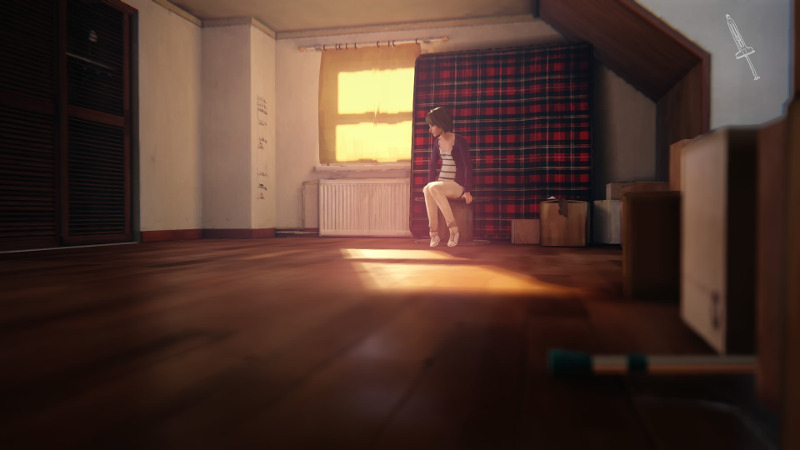
"Do your powers include mind reading? Or did you just rewind because I tried to steal the cozy chair?"
Some of you might remember my Walking Dead review, where I talked quite glowingly about Telltale Games' feels trip masquerading as interactive adventure with zombies. This time, I'm covering something that's basically the same, sans zombies and plus the Pacific Northwest. Also, sort-of time travel. Is it as good as The Walking Dead? Is it, dare I say, better? Find out what Life is Strange has in store for you...
This review will be spoiler-free, containing no plot details beyond the basic premise that I mentioned above.
Note: I originally posted this review on The Catholic Geeks, but intend to follow up on it more in-depth here.
What Sets Life is Strange Apart
Like The Walking Dead, Life is Strange is a combination of three genres, melding them into a cohesive experience intended to engage you powerfully and personally:- Adventure games: you interact with the environment, able to inspect a large number of objects in each scene and interact with most of the characters present. In order to progress through each scene, you often have to do certain things, and there's sometimes multiple options you have in a given scene, although some of them are hidden and require some exploration.
- Visual novels: you progress through the game by making choices during dialogue, and choices you make earlier in the game can ripple out and have effects later on. Traditionally, visual novels also feature multiple endings, including one canonical "true ending" that you have to go through an immense amount of effort to unlock.
- Cinematic games: games designed to have evocative, immersive narratives, trying to meld gameplay with thematic play, often via "quick time events" that link in-game actions abstractly to pressing specific keys in a particular sequence (kinda like Simon Says).
While The Walking Dead leaned heavily on the "cinematic games" element, even including a simplified form of quick time events, Life is Strange moves solidly into the "adventure game" category, while still keeping the cinematic atmosphere, even prominently using camera angles and music during key scenes. There's also a considerably larger emphasis on choice here, with more visible consequences.
This focus on choice correlates interestingly with a core game mechanic: rewinding time, a power which the main character mysteriously acquires very early in the game's first act (of five). Whenever you make a choice in the game, you can almost always rewind previous to that choice and then make another choice instead. This probably sounds like it undermines the purpose of the choice entirely, but in practice, I found it to do the opposite. Since I was able to see immediate consequences of my choices, it encouraged me to experiment, and it also added more weight when I finally committed to a big decision, since I knew what was coming. Also, the power can only rewind so far (you can't go back after leaving a scene in the game), and some choices have consequences far into the future, so there's still an element of suspense, especially when you've made a choice and don't immediately see consequences.
To all of you
American girls, it's sad to
Imagine a world without you
American girls I'd like to
Be part of the world around you
Driving a car by the seaside
Watching the world from the bright side, yeah
Snapshotting the Protagonist
Moreso than any game I've played, Life is Strange aims to pull you deeply into the mind and heart of its protagonist, who is anything but a blank slate protagonist. She might start out as a somewhat meek and impressionable wallflower, but the game takes full advantage of its adventure game heritage to build a portrait of promising young photographer Max Caulfield, giving you more and more context for the choices you make.Max is a student at the prestigious Blackwell Academy in Arcadia Bay, her childhood town. Then she runs right into a mystery/drama story, with stakes both personal and large-scale, topped with a layer of cryptic symbols and messages. There's a lot of old personal history that underlies the plot, interwoven through the present-day drama largely through in-game artifacts. Since this is an adventure game, the primary activity of the game is finding and interacting with objects, which are helpfully highlighted with a circle and a name when you get close enough. Focusing on an object shows ways that Max can interact with it, always including the adventure game staple "Look", which gets you a little bit of Max commentary on the object. Not only do you get this for all the important objects in the scene, but there's also several objects that exist just to help you get a clearer picture of Max's viewpoint. She doesn't just observe things--she reacts to them, and that reaction captures her frame of mind in a way that wouldn't work in another medium.
Going beyond that, the game uses the clever conceit of a personal journal as a "pause screen" (a functional use) that doubles as a peek into the protagonist. If you want to spend your time exploring, you can read a page-by-page recap of the story from Max's perspective (quite useful if you've forgotten some things that happened the last time you played), check her text messaging with different characters (delivering a unique style of narrative on top of the more traditional dialogue), and read through her writeups on the other main characters (which sadly stay static throughout the game, but are a good resource for grounding you in the supporting cast). I enjoyed this touch, because it feels real and also gives background information, but only when you feel like exploring it, instead of trying to frontload all of this background into you, which usually means you'll forget it anyway.
This is also the only game I've played that has a built-in soliloquy mechanic. Sometimes, you'll encounter an object in the game that only has one interaction: "Sit". When you do this, Max sits down, and the music switches to something calming and introspective as the camera pans around the scene. Then, Max starts thinking about everything that's been going on recently, processing the story and letting us in on the moment. It's a really cool way to connect with the character, and the game doesn't stop the "moment of calm" until you decide to get up, which means that it also works well as a way to relieve some of the tension that's built up, if you need to.

Making Hard Choices
The core of Life is Strange is the choices you make throughout the game. Sometimes, they're small, almost incidental, like many of the choices you can make during dialogue, which shape the tone of the conversation but don't usually have long-lasting impact. Other times, a choice will have fairly significant consequences for Max or (usually) other characters. Every so often, the game pulls out all the stops, and gives you a massive, dramatic choice, blurring out the scene to focus on two options (which tend to be polarized). These choices are the highlight of the story, often with very far-reaching results that you won't be able to see immediately.Here is where the game melds most closely with its visual novel ancestry. One peculiar phenomenon in visual novels is the robust save-state mechanics that often appear. This has to do with the way your choices impact the narrative: achieving specific endings in the game often requires precise combinations of choices made together. Along with the fact that visual novels track completion percentage, this means that players frequently attempt to go through all of the possible options in a visual novel. Since it would be tedious to replay the whole game, players can instead use a large number of save slots to "freeze" the game at critical decision points, making one decision and then later coming back and making the other decision in a following playthrough.
In Life is Strange, being able to rewind back through decision points accomplishes most of this, although you're not able to backtrack after a significant amount of time. It still asks for commitment, but you can at least explore your options when you make a choice. What's interesting is how the game uses this to reflect back on Max's power and her character. If you start to change how you're making choices based on people's reactions to them, are you really just using your power to manipulate their actions? How far is too far? It's an intentionally understated question that creeps beneath the surface of the game, setting the stage for the final powerful choice in the game.
My Final Take
Life is Strange is a potent examination of choice, leaning on all the consequences that can stem from your actions. It uses the mechanic of rewinding time (along with side themes of photography as a way to snapshot the past) to underscore its key themes, while also drawing you into a world filled with characters who have hopes, fears, and motivations.It's certainly not perfect. Lip-sync is sometimes off or even missing in some scenes (during one pivotal scene in the fifth episode, there's a large amount of time where Max's lips aren't animated to move at all), which can be distracting. Some of the conversations have a really clunky flow since they're moving from choice to choice, and a character's reply will sometimes feel very tonally disjointed from what you just said. Some of the dialogue also feels a little stilted, although it is at least partially based off of teen dialect in the Pacific Northwest, which is a cool touch.
I found that, despite its awkward, almost teenaged, flaws, Life is Strange pulls you into an emotionally-compelling story, showing you the struggle of a young, vulnerable heart to make sense of the world. It's often melancholy, sometimes funny, sometimes nostalgic, sometimes intense, and it all builds to a powerful finale. As the ending cutscene played, I sat back, still not sure if I had chosen wisely. I made my call, and knew I had to live with it. I don't think Max was the only one whose heart grew during that journey.
Life is Strange is available for a plethora of systems (PC, XBox 360, XBox One, PS3, PS4), although if you're getting it for PC, double-check those system requirements. It's not designed to be playable on just any system.
Content Advisory: frequent coarse language; scenes of blood and violence; scenes of emotional abuse; threatened sexual assault
P.S. If you're reading this before July 5th, 2017, the game is currently on sale for $5 at Steam!
No comments :
Post a Comment